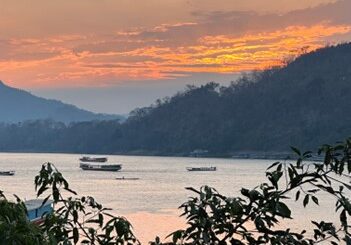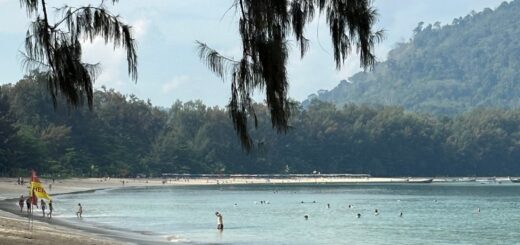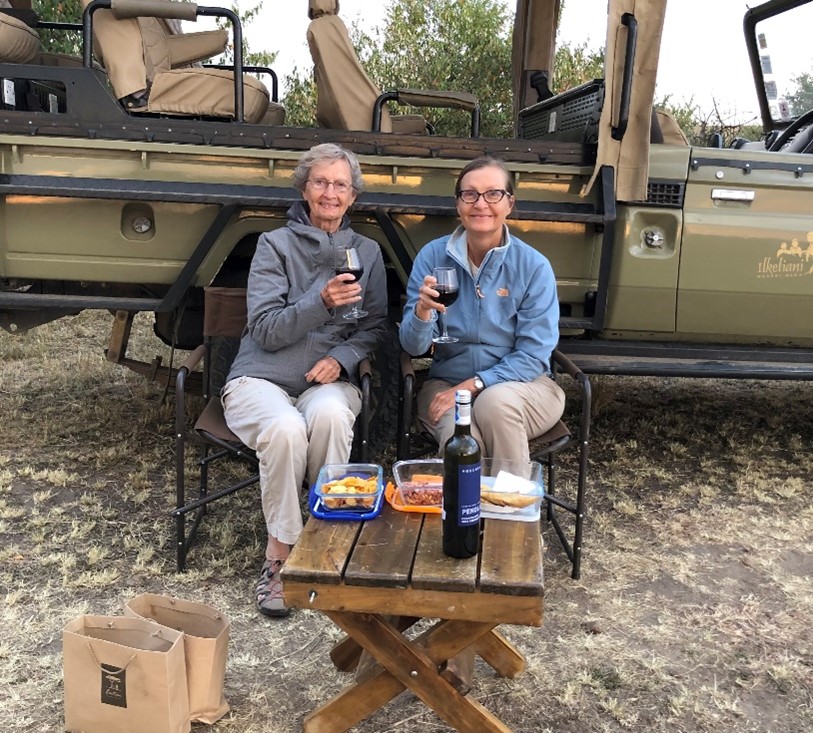Bangkok
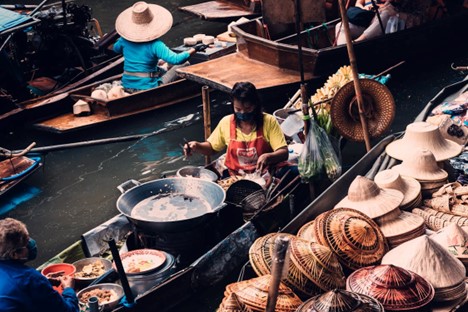
Travel Advice for Seniors: Bangkok
We try to create trip itineraries that have something exciting for each day, but we like to make sure that we save some real bang for the end of the trip. Hence, Bangkok!
We arrived Bangkok from Luang Prabang, Laos and looked forward to spending three full days exploring the city, which was hardly enough time.
Bangkok is the capital city of Thailand and is very cosmopolitan and international. First settled in the fifteenth century, it became the capital in 1782. There is something for everyone in Bangkok. Ornate shrines, a fascinating cultural heritage and vibrant street life combine in majestic beauty here. The boat-filled Chao Phraya River feeds a network of canals and makes for an entertaining mode of travel.
We loved it here, even though we were traveling during a hot spell in February. We just made time to slow down and find some cool places in the afternoons, carry plenty of water, apply sunscreen regularly and of course, wear a hat.
Thailand is a magical country. The people are friendly and there is so much to see and do and eat! From the mountainous north to the balmy beaches of Phuket and Krabi. It is indeed paradise.
Interestingly, the easy-going Thai people also seem to prefer a mix of Buddhism, Hindu gods and traditional local gods be incorporated into some of their temples. This makes some of their temples an interesting mash-up of a variety of styles and symbols, both religious and superstitious. However, I do love the steeply slanted rooflines and the elaborate finials that are unique to Thai temple architecture.
It’s pretty easy to get around Bangkok and there are several modes of transportation available including tuk tuks, which are similar to a golf cart in the US, only I with three wheels. They can easily get around the busy streets and are a popular means of conveyance.
Politically, Thailand has been a western-style democratic monarchy since1932, however, most of the time it has been ruled by military governments. When we visited, there was some dissatisfaction with the current King, unlike his very popular father. However, best to leave this discussion alone as this kind of talk is against the law here.
So back to Bangkok! We arrived in the evening and went immediately on a food tour. It was a Saturday night, and it was rockin’! The main area we were in was Yaowarat / Chinatown. There were wall-to-wall food vendors and wall-to-wall people. We tried pad thai, Tom Kha soup and many other delicacies. It was fascinating to people-watch and to look at all of the foods on offer. We did have to call it a night early as it was a warm evening and the food vendors all had open grills, making it even hotter, plus a long day and a flight…we were happy to find some air-conditioning!
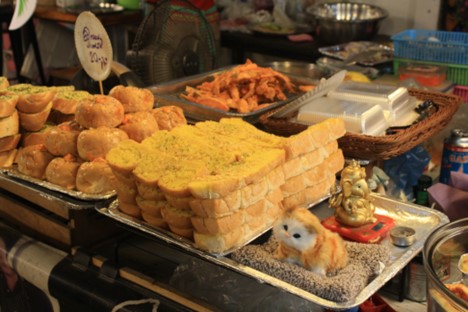
Our first full day, first stop, was an early morning trip to the market at Klon lat Mayam, a floating market in the Taling Chan district. This was a local food and produce market that sold a few souvenirs. We sampled several different types of interesting food that were delicious. The market is floating, not because it is all on boats, even though the produce was delivered by personal boat, it is floating because this entire market sits on pontoons. It was a fun experience poking around and sampling. Not accessible.
We love going to markets and supermarkets, because you can employ “grocery store tourism” which is checking out what unique items each country has on offer and possibly see some items with curious English names that obviously don’t mean what they are describing in the package. Also, excellent shopping tip here: We buy a lot of gifts for friends at these markets and at foreign supermarkets. Everyone likes chocolate, cookies, candy, coffee or beer, right? Much better than a tchotchke.
After browsing and sampling, we took a boat ride around some of the canals to view some of the many, many temples in Bangkok and made a stop at an Orchid Farm, which was in a sizeable greenhouse. Many unique colors and sizes of orchids, some very rare were on view here.
For the afternoon we headed for some air-conditioning and the National Museum. There is lots to see at this museum, also called the Bangkok Museum. Allocate at least a couple of hours to view the historic exhibits and don’t miss the royal artifacts including thrones from the Ayutthaya palace, the ceremonial chariots and the Buddhaisawan Chapel with its significant Buddha image.Some accessibility.
When we finished the National Museum, we went to the nearby Wat Arun. Wat Arun is one of Bangkok’s most important Buddhist temples. It’s named after Aruna, the Hindu god of dawn. The distinctive spire or “prang” of this temple is the highest in Bangkok and its beauty makes it a landmark. Its shape is meant to evoke Mount Meru, the center of the world in Tibetan Buddhist teachings. The inside features a golden Buddha and many Chinese soldiers and animal sculptures. It is a working temple, so remember, as with any temple, dress modestly and keep your voice down.Accessible.
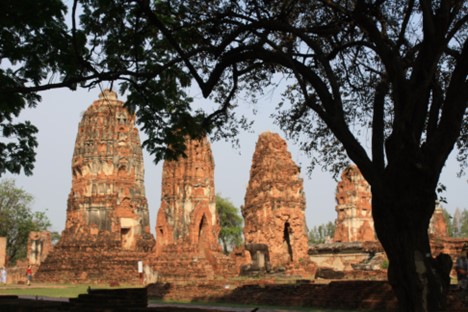
On our second day we went on a daytrip to the ancient historical park of Ayutthaya, a UNESCO Heritage Site. Founded in 1350, Ayutthaya was the second capital of the Siamese Kingdom. It flourished from the 14th to the 18th centuries, during which it became a very important trade center. It has ruins of several important temples, reliquary towers and monasteries. As a sidenote, when we visited, the lavatory was pay and you had to pay separately for toilet paper(!) Generally accessible, but pathways can be uneven.
We also visited a local Muslim Market and went on a short river cruise on Chao Phraya, the “River of Kings”. Along the river, we visited Wat Niwet Thammaprawat Ratchaworawihan, a Buddhist temple located within the grounds of the Bang Pa-In Royal Summer Palace. Curiously, it is of European architectural style with wonderful stained-glass windows.
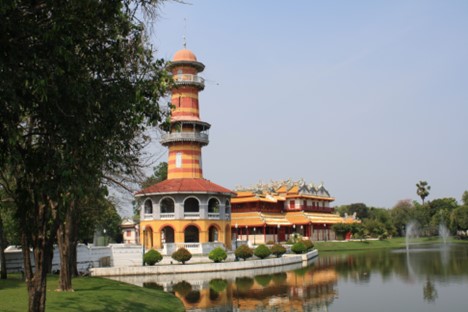
Bang Pa-In Palace is a sprawling complex of temples, palaces and gardens, originally built in 1632 by King Prasat Thong and revived in the 19th century by kings Rama IV and V who added many of the European design elements. It is a combination of several different styles of architecture but is still very striking. Also, it’s wheelchair accessible and a pretty smooth walk, though it does take a couple of hours if you go into the buildings and explore everything properly. Comfortable shoes, sunscreen, a hat and plenty of water should be included in your day bag, especially if you are visiting in February as we were.Accessible though some interiors may be difficult to navigate.
It was a nice day trip and it’s always a pleasure to get out of the city and see a bit of the country and local villages.
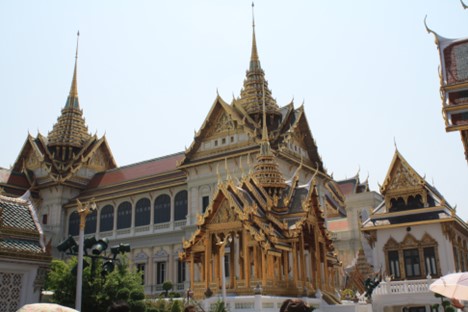
Saving the best for the last day in Bangkok! We used local transport all day including the Skytram, boats and tuk tuks which made the day more interesting. We started at Wat Pho and the Grand Palace. Wat Pho is the home of the gold-plated, 46 meter long Reclining Buddha, which is an incredible sight. It’s so big, it’s hard to get a photo that shows the size! The temple complex houses the largest collection of Buddha figurines in Thailand. Plan on spending a bit of time here to peruse the treasures. Accessible ramps and pathways, though some areas may be inaccessible.
Next up was the Grand Palace, home to the Kings of Siam 1782 -1925. This and the Wat Phra Kaew or the Temple of the Emerald Buddha are in the same compound and are “must see” destinations. Besides the incredible architecture, the palace also has a great deal of historical and cultural information. Even though it is usually crowded with tourists, it is still worth an hour or two to see it. Accessible with some limitations.
Wat Phra Kaew or the Temple of the Emerald Buddha, is regarded as the most sacred Buddhist temple in Thailand. Finished in 1785 by King Rama, it was originally commissioned to house the Emerald Buddha, a highly revered icon. The icon is believed to bring prosperity and protection to the nation and legitimacy to the Thai royal family. Royal ceremonies and important events often take place here, underscoring its national importance.
Next stop was Soi Ban Batra for a look at the monk’s alms bowl makers that frequent this area of Bangkok. And the final stop was at the Jim Thompson House. Jim Thompson is an American who was known for starting the Thai silk industry after World War II. Note that you must pay extra to go into some of the adjacent buildings. It’s a pretty house and the history is interesting, but there are probably other more important sights to see in Bangkok.Accessible parking and entrance but most of the house is not accessible.
And just because everyone has heard this about Bangkok, the “red light” districts are Patong, Nana Plaza, Soi Cowboy, Khaosan. There are bars, brothels and sexy shows in each area. Don’t think I need to elaborate here.
Bangkok was one of those cities where you can spend a week or even months discovering new things and enjoying the culture. We had limited time and still had the beach at Phuket left on our four-week tour through Southeast Asia…so onward!
Where we stayed: Rose Residence. Breakfast included. Very nice hotel, good location.Inexpensive lanudry around the corner. Accessible.
How we got there: Flew to Bangkok from Luang Prabang,then private transfer to hotel.This was part of a four-week private tour through Southeast Asia, touring Vietnam, Cambodia, Laos and Thailand.
General Accessibility Information: See notes above. Thailand is generally not considered very handicapped accessible, with limited wheelchair accessibility in most places. Some tour operators offer accessible tours, and some high-end hotels are accessible. Some attractions in larger cities have wheelchair access.Call in advance to verify and make specialty arrangements.However, see our sections on specialty apps and accessible travel for more on accessibility assistance.


